Choosing the right swimwear fabric is one of the most important decisions for any swimwear brand. The material you use determines not only how the product looks and feels—but also how it performs, lasts, and reflects your brand values.
From elasticity to chlorine resistance, and from sustainable sourcing to pricing, fabric plays a crucial role.
Whether you’re launching a startup or scaling a growing swimwear line, this guide will help you understand the most commonly used fabrics, their pros and cons, and how to choose what’s right for your designs and target market.
What are the properties of swimwear fabric?
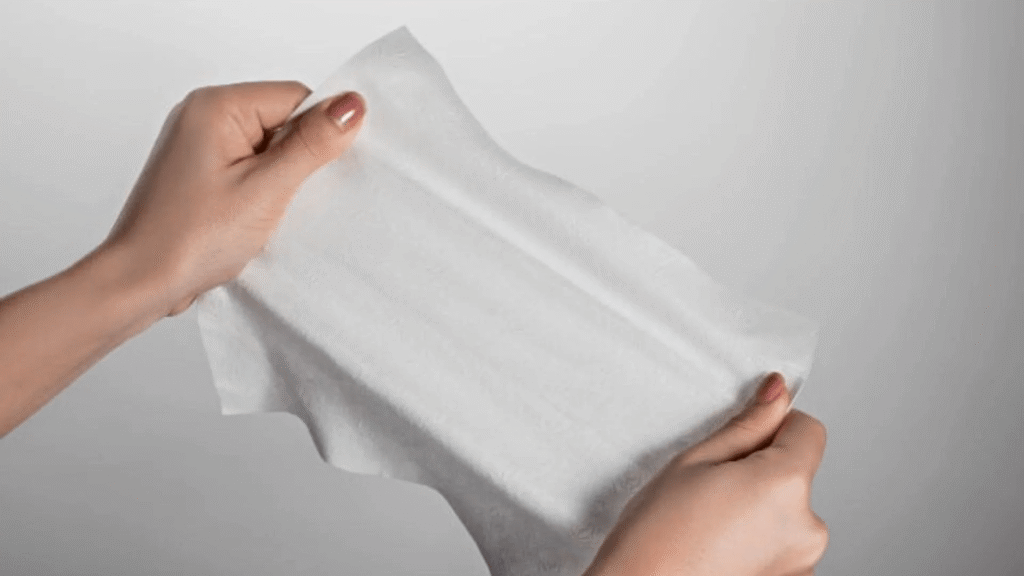
Swimwear fabrics are specially engineered to meet the demands of swimming, sun exposure, and movement. The ideal swimwear fabric needs to balance comfort, performance, durability, and aesthetics.
Here are the key properties to look for in high-quality swimwear fabric:
1.Stretch and Elasticity
Swimwear fabric must offer 4-way stretch to move with the body and provide a snug, flattering fit. This flexibility ensures comfort during swimming, lounging, or active beachwear, without feeling restrictive or sagging.
2. Chlorine Resistance
Chlorine-resistant fabrics are essential for swimwear used in pools. They prevent fiber breakdown, fading, and stretching caused by repeated chlorine exposure, keeping the garment in good condition for a longer time.
3. UV Protection
High-quality swimwear fabric often includes UPF (Ultraviolet Protection Factor) to block harmful sun rays. This helps protect the skin from sunburn and UV damage, especially during extended outdoor activities.
4. Quick Drying
Quick-dry fabrics reduce water retention and discomfort after swimming. They help the swimsuit dry fast on the body or when hung up, making them ideal for active beachgoers and travel use.
5. Shape Retention
Good swimwear fabric maintains its shape after multiple wears and washes. It resists stretching out, sagging, or becoming loose, which is important for both aesthetic appeal and long-term wearability.
6. Colorfastness
Colorfast fabrics retain their vibrancy even after exposure to sun, saltwater, or chlorine. This ensures the swimsuit looks fresh and new, avoiding dull or faded appearances over time.
7. Softness and Comfor
High-quality fabric feels smooth and comfortable, preventing irritation or itching, and offering a better overall wearing experience.
Best Materials Used in Swimwear
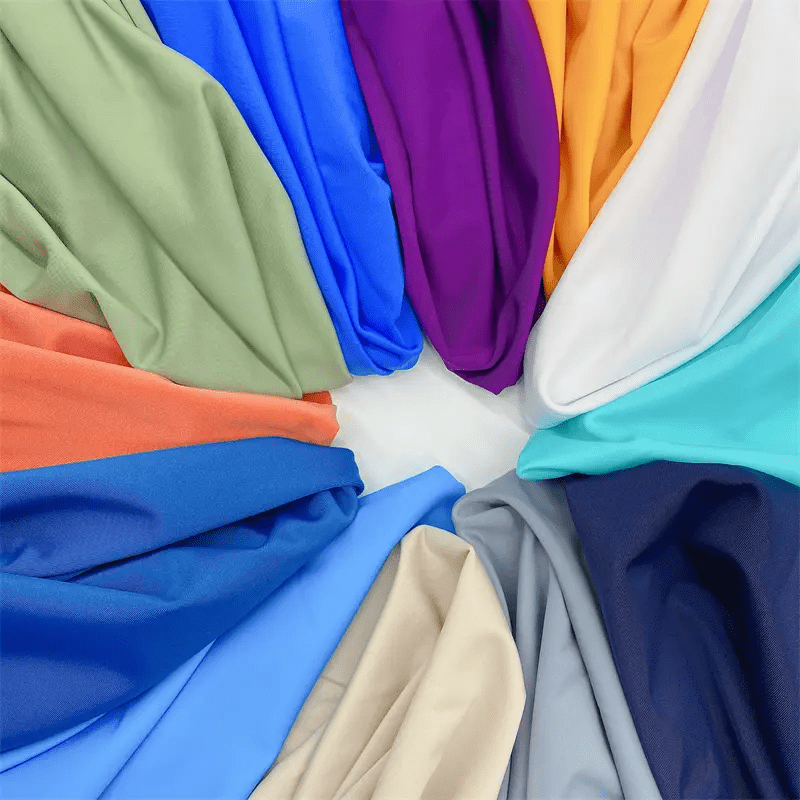
1. Nylon
Nylon is one of the most common fabrics in swimwear production thanks to its lightweight feel, excellent elasticity, and smooth hand-feel. It offers a sleek, second-skin look that’s popular in bikinis and one-pieces alike.
Pros::
- Soft and comfortable
- High stretch and recovery
- Vibrant color performance
Cons:缺点:
- Lower chlorine resistance
- Can lose shape over time with heavy use
Best for: Fashion-forward designs, soft-touch swimwear, lifestyle collections
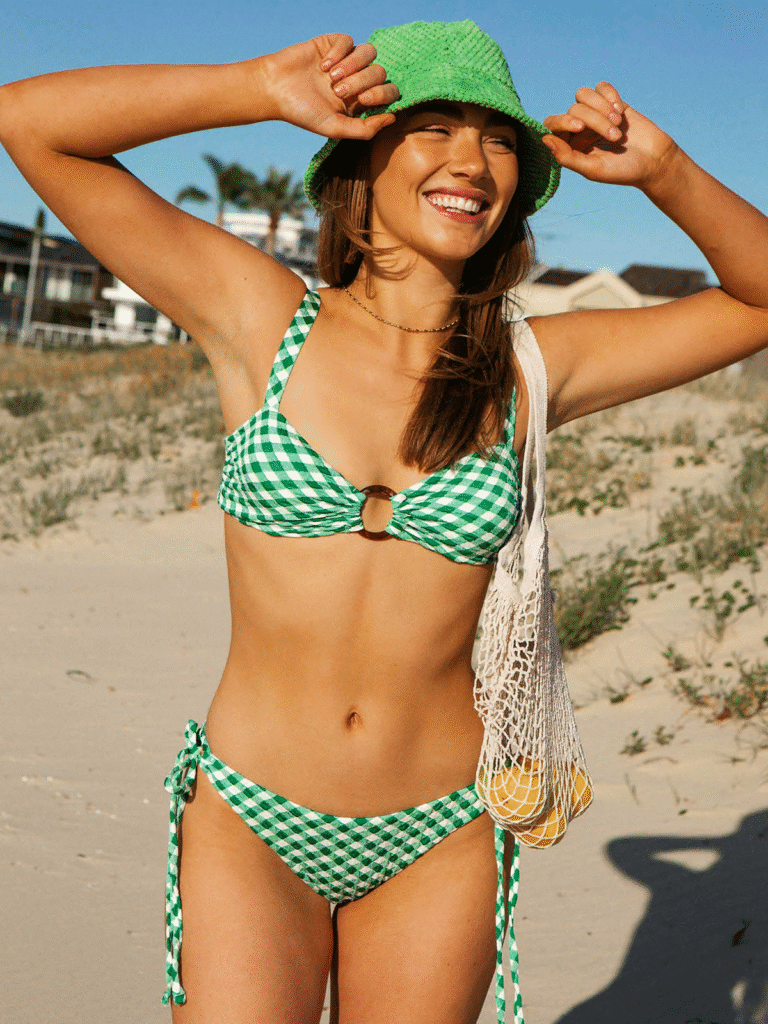
2. Polyester
Polyester is more durable than nylon, especially when it comes to chlorine and UV resistance. It’s the go-to for active swimwear, competitive swimwear, and styles that demand long-lasting performance.
Pros::
- Excellent colorfastness
- High chlorine and UV resistance
- More sustainable than nylon when recycled
Cons:
- Slightly stiffer hand-feel than nylon
- Less stretchy (needs spandex blend for comfort)
Best for: Training suits, outdoor or water park styles.

3.Spandex (Elastane / Lycra®)
Spandex is not used alone but blended with nylon or polyester to add stretch and flexibility. A quality swimwear fabric usually contains 15–25% spandex to ensure comfort and shape retention.
Pros::
- Exceptional stretch
- Shape memory
- Flexible across sizes
Cons::
- Sensitive to high heat during care or printing
Best for: All swimwear—used in nearly every fabric blend
4.Sustainable Swimwear Fabrics
As conscious consumerism grows, many brands are turning to eco-friendly swimwear fabrics that don’t compromise on performance.
Recycled Nylon
Made from reclaimed materials like fishing nets and industrial waste, recycled nylon performs like virgin nylon—only greener.
Pros::
- Reduces landfill and ocean waste
- High elasticity and softness
- Same performance as standard nylon
Cons::
- Slightly higher cost
- MOQ requirements (but manageable: we support 100 pcs/color)
Best for: Eco-conscious brands, high-end swimwear, minimalist designs
Recycled Polyester
Recycled from post-consumer plastic bottles, rPET is an environmentally-friendly alternative to virgin polyester. It’s highly durable and ideal for active swimwear.
Pros:
- Strong and durable
- Chlorine-resistant
- More sustainable supply chain
Cons:
- Texture slightly rougher than recycled nylon
- May require extra softening treatments
Best for: Athletic swimwear, eco lines
5.PBT (Polybutylene Terephthalate)
PBT (polybutylene terephthalate) is a type of polyester known for high chlorine resistance and shape retention. Often blended with polyester, PBT offers outstanding chlorine resistance and is commonly used in competitive swimwear.
Pros:
- Long-lasting in chlorine pools
- Great shape retention
- Textured feel that resists snags
Cons:
- Less elasticity than spandex blends
Best for: Performance swimwear, training suits,
Common Swimwear Fabric Blends

When choosing swimwear fabric, it’s not just about the type of material — the blend ratio also plays a key role in determining how the swimsuit performs and feels.
Most swimwear fabrics are blends of two or more fibers, commonly:
80% Nylon / 20% Spandex – This is one of the most popular combinations. Nylon provides strength and smoothness, while Spandex (also known as Elastane or Lycra) ensures stretch and flexibility. This blend strikes a great balance between comfort, shape retention, and durability.
85% Polyester / 15% Spandex – Often used for printed swimwear, this blend is more chlorine-resistant and holds color well, making it ideal for pool environments.
PBT Blends – PBT (Polybutylene Terephthalate) is sometimes blended with Polyester or used on its own for performance swimwear. It’s highly chlorine-resistant and retains shape over long use.
How Fabric Blend Ratios Affect Performance
Higher Spandex content (18–25%): More stretch and body-contouring feel, often used in fashion-forward or tight-fitting designs — but may lose elasticity faster with frequent chlorine exposure.
Lower Spandex content (10–15%): Better durability and shape retention, suitable for sports swimwear or bulk production needs.
Higher Nylon or Polyester base: Impacts drying speed, durability, and surface texture (shiny, matte, textured, etc.).
Tip: Always consider your design’s goal — a shaping bikini for beachwear may need higher Spandex, while a chlorine-proof swimsuit for training may benefit from a PBT-rich blend.
Surface Finish & Style Considerations
In addition to choosing the base fabric, the finish and texture also impact the final look:
Matte fabrics swimsuit: Subtle, elegant, non-reflective finish (ideal for minimalist or luxury brands)
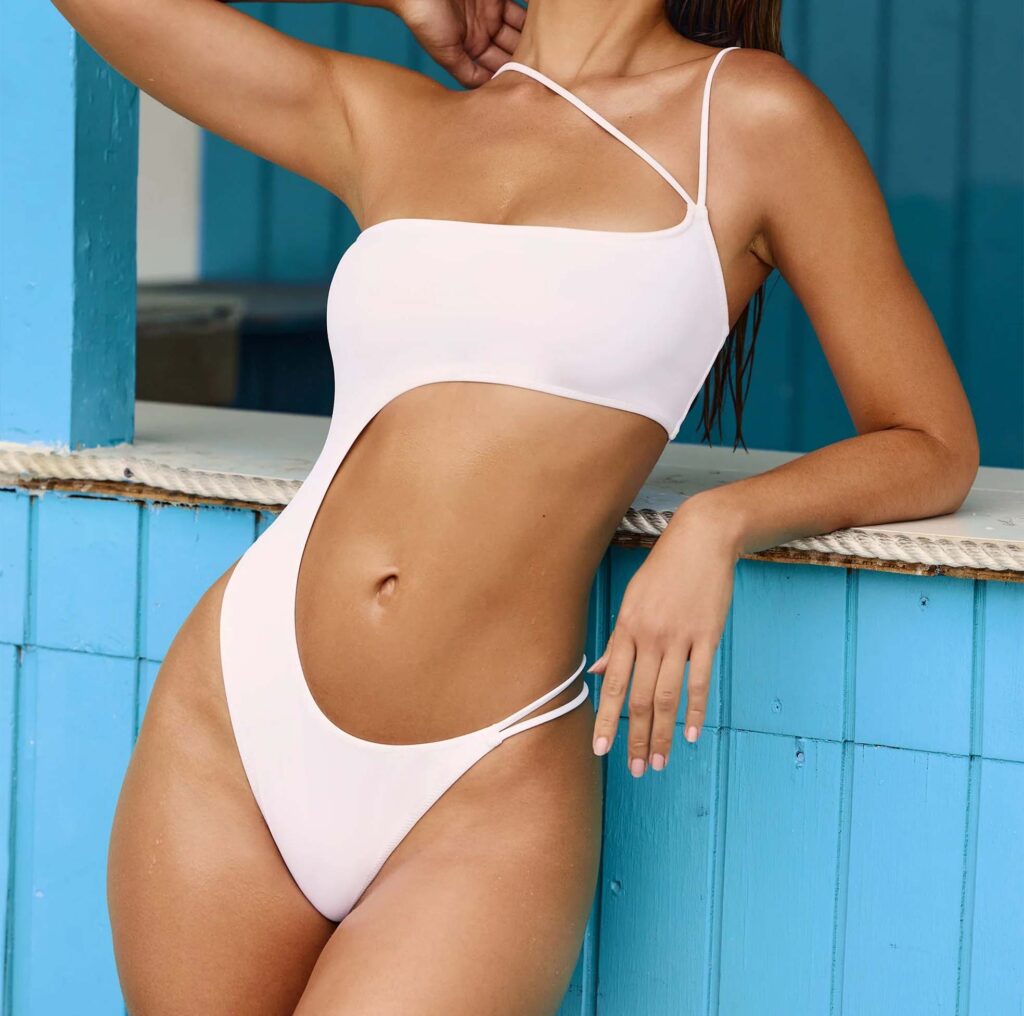
Shiny fabrics bikini: Glossy, reflective, eye-catching (great for bold, sexy styles)
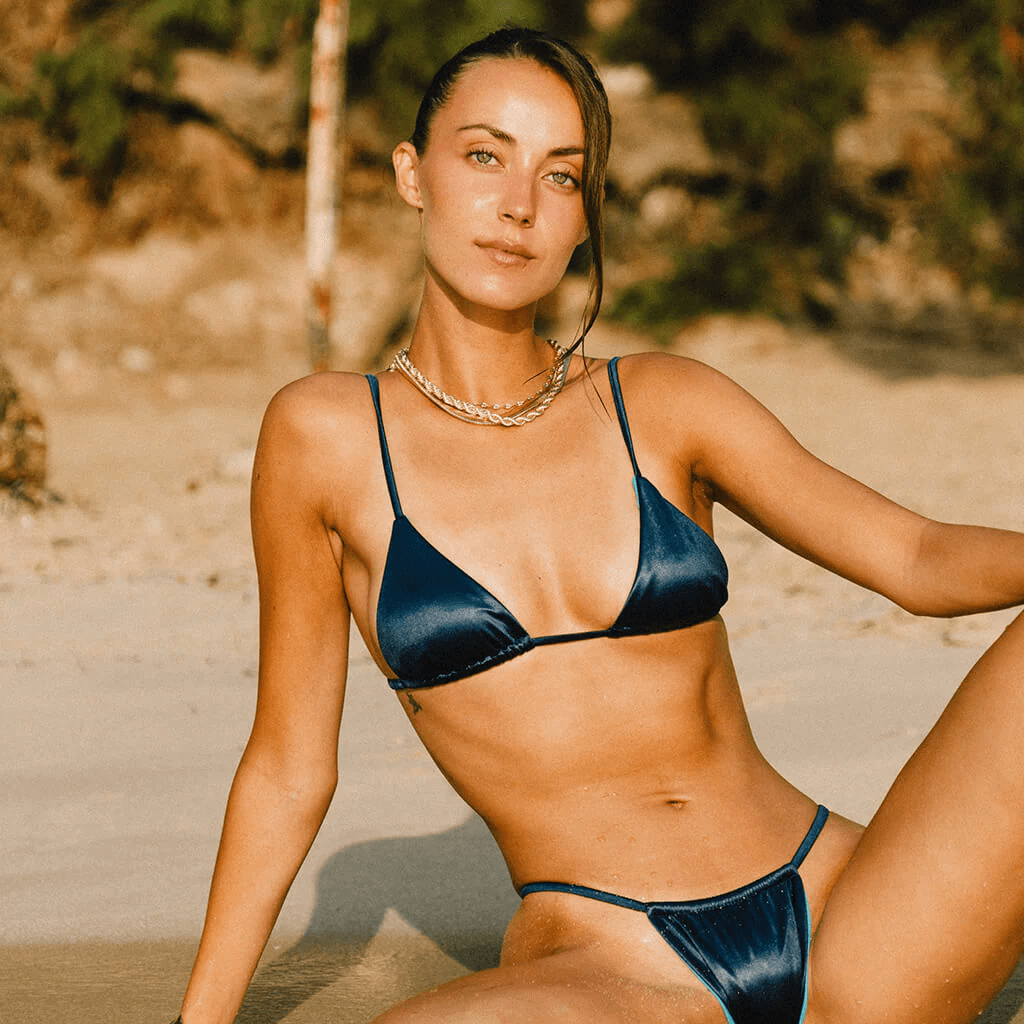
Textured fabrics bikini: Ribbed, crinkled, or jacquard patterns (adds visual interest and structure)

Printed fabrics: Digital or sublimation prints are highly customizable
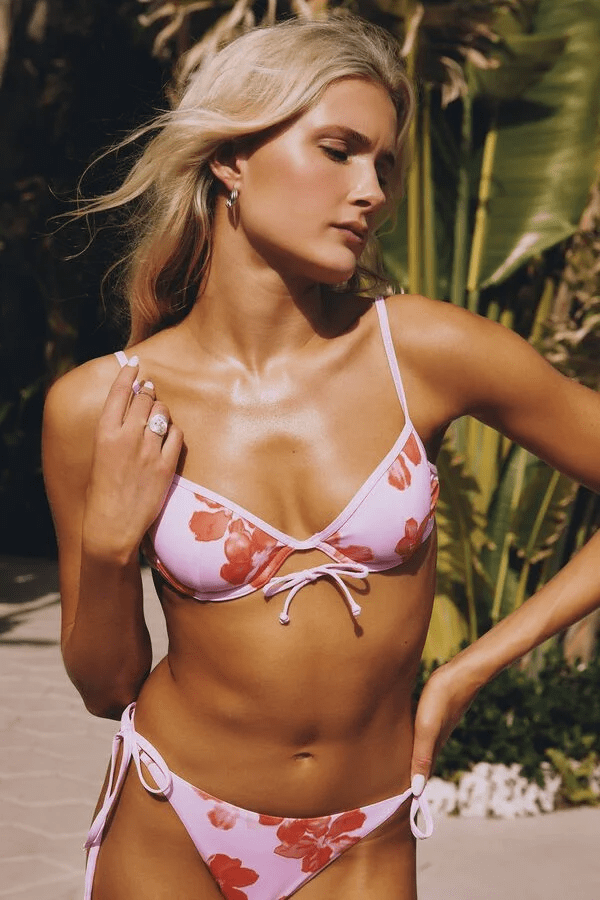
We recommend always matching fabric type with swimsuit structure. For example, soft and light fabrics are perfect for ruched bikini tops, while thicker matte fabrics are better for shaping one-pieces.
What to Consider When Choosing Swimwear Fabrics
- Use Case: Pool training, beach vacations, surfing, or lounging all require different priorities.
- Body Contour & Support: Thicker fabrics with high spandex content offer shaping benefits.
- Brand Positioning: Eco-fabrics align with ethical brands; shiny/matte textures align with fashion trends.
- Printing & Dyeing Needs: Polyester holds sublimation prints better; nylon is better for deep colors.
- Customer Comfort: Softness, stretch, and breathability directly impact satisfaction.
Common Mistakes When Choosing Swimwear Fabric
Only judging by hand-feel: A soft fabric may not hold shape well in water. Always ask for stretch and thickness data.
Ignoring fabric thickness: Too thin, and the swimsuit becomes see-through. Too thick, and it becomes stiff and hot
Overlooking MOQ: Many mills require large minimums, but we offer low MOQs (50–100 pcs per color) to help small brands launch easily.
Conclusion
Choosing the right material isn’t just about trend—it’s about performance, longevity, and brand alignment. By understanding the strengths and limitations of each fabric, you can confidently select materials that elevate your designs and satisfy your customers.
At Joy Sportwear, we help swimwear brands source the best fabrics for their unique needs, from sustainable options to high-performance blends. Whether you’re building a high-fashion resort line or a chlorine-resistant training collection, we’ve got you covered.
FAQ:
Two of the most common and reliable fabric combinations in swimwear are nylon and spandex. These two fabrics combine to create durable, slimming and comfortable swimwear.
Recycled nylon is made from post-consumer waste like fishing nets and fabric scraps, while regular nylon is derived from petroleum. Both offer similar performance, but recycled nylon is more eco-friendly and supports circular fashion.
Generally, yes. Sustainable materials like recycled nylon or recycled polyester tend to cost 10–20% more than conventional fabrics. However, many brands find the added value and marketing appeal well worth the investment.
PBT (polybutylene terephthalate) is a type of polyester known for high chlorine resistance and shape retention. It’s ideal for competitive or training swimwear used frequently in pools.
Nylon and polyester blends are the most popular quick-dry options. Recycled versions of these fabrics also offer fast-drying properties while being more sustainable.
Matte fabrics have a soft, non-reflective finish that gives a minimalist and modern look, while shiny fabrics have a glossy surface that adds vibrancy and catches light—often used in statement swimwear.
PBT is the most chlorine-resistant swimwear fabric. It’s suitable for swimwear that is regularly exposed to chlorinated pools, such as competitive suits or training bikinis.
Yes. At Joy Sportwear, our MOQ for each color of swimwear fabric—is just 50 pieces.( Recycle fabric is 100pcs/color)This makes it easier for small brands and new entrepreneurs to start production.

